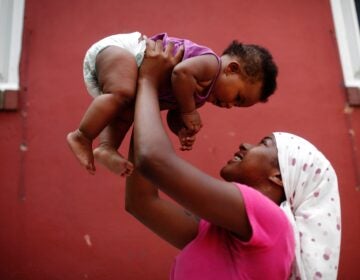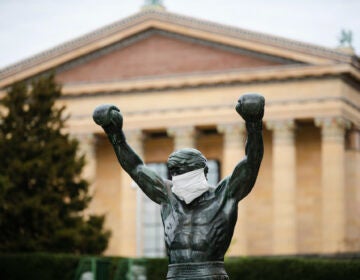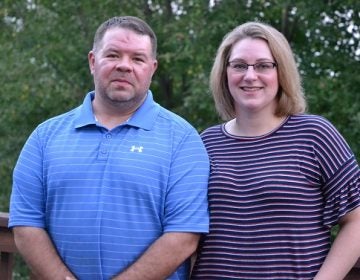For brain surgery patient, greatest challenge is motherhood
To many people, she is remembered as the girl with half a brain. But Christina Santhouse knows there are two little girls who will only know her as something else: Mom.
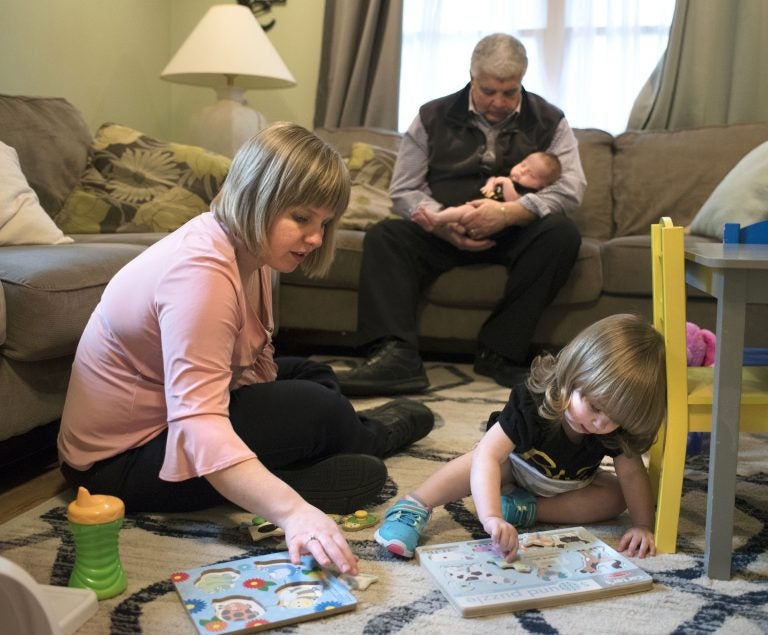
Christina Paravecchia, plays with daughter Madelyn Rose as her dad, Albert “Two-pops” Catarro helps out by holding baby Amelia Grace who was born March 20. Christina had half her brain removed in 1996, when she was eight-years-old. (William Johnson/The Intelligencer via AP)
To many people, she is remembered as the little girl with half a brain. But Christina Santhouse, now Paravecchia, knows there are two little girls who will only know her as something else: Mom.
At 8 years old, Christina Santhouse started a new life in a less cooperative body.
The most routine activities such as bathing, dressing, walking and eating with utensils had to be learned a second time. It was the hardest thing she would ever do — until she became a mom.
Suddenly, the unimaginable obstacles she overcame after losing half her brain 23 years ago don’t seem as daunting.
Not compared to diaper changes, bottle feeding a squirmy newborn or securing two kids in car seats, with only one working arm. Not compared to lifting a toddler with one arm and a partially paralyzed leg. Not compared to chasing a toddler who has figured out she walks faster than mommy can run.
Motherhood is the greatest challenge that Christina has undertaken. The most rewarding one, too.
“It’s beyond my wildest dreams how much I love them.”
Christina, now 32, has approached parenthood the same way she has everything else in her life since her 1996 surgery and rehabilitation made her a medical marvel.
A lot of planning. A lot of preparation. A lot of faith. A lot of determination.
There also is a lot of help and a lot of love from family, especially husband Vince, 35, who she married in 2014, less than two years after they met in a church Bible study group.
The Lower Makefield couple knew they wanted children, but they were unsure if they could have their own.
Would pregnancy put Christina’s health at risk? Could the hormonal changes resurrect the violent seizures that shook her body 150 times a day as a child? Could the stress of labor trigger a stroke during delivery?
“We were so scared,” Vince said.
Medical opinion
Scientists don’t know what causes Rasmussen’s encephalitis, the rare and deadly inflammatory neurological disease that invaded the right half of Christina’s brain as a child and resulted in her undergoing a type of brain surgery so risky that it’s rarely performed today. The operation saved her life, but it left Christina with a permanent reminder: left-side paralysis.
Roughly 1,000 U.S. families are registered with the Hemispherectomy Foundation, a Texas-based nonprofit, which tracks individuals who undergo the surgery. The foundation is aware of a handful of so-called “Hemi” moms, but it’s definitely exceptional, according to co-founder Kristi Hall.
So before the couple decided how they’d start a family, they consulted with a neurologist. He consulted a neurosurgeon and a rehabilitation medicine specialist. Then they saw an OB-GYN and a perinatal specialist.
They all came to the same conclusion: Pregnancy was a safe option.
Dr. Christopher Skidmore, a neurologist at Thomas Jefferson University Hospital, isn’t aware of other anatomical hemispherectomy patients who’ve given birth. Christina is the first patient in his career who he has seen who had the surgery.
Yet Skidmore said he wasn’t worried about the seizures returning since the diseased half of her brain is gone. The only possible problem might be difficulty pushing during delivery because her left side is weak, he said — as well as the physical challenges of providing care after the baby is born.
While doctors were confident, one more person needed reassurance: Christina’s mother.
‘Oh my God’
Lynne Catarro is the first to admit she is overprotective when it comes to her only child.
For so many years it was just the two of them, until Catarro met her future husband, Albert Catarro, around the time Christina was diagnosed with Rasmussen’s.
Lynne Catarro, 57, of Bristol Township, a retired Cherry Hill, New Jersey, special education teacher, was beside her daughter before, during and long after surgery and rehabilitation as her patient advocate, life coach and drill sergeant.
To say Catarro was skeptical about the pregnancy is like calling Mount Everest an anthill. Rasmussen’s is not considered a hereditary illness, but she heard stories from other parents about women who had the same surgery as Christina and got pregnant. The stories did not end well, she said. One woman had her seizures return. Another sank into a deep depression.
“[It] even got to the point where I went in with Christina [to doctor appointments] and gave them the information, and basically their response was, ‘She is fine,'” Catarro recalled. “They had to convince me. And the doctors did convince me. It was just that mama bear coming out of me.”
Catarro was the first person who suspected Christina was pregnant. One afternoon during a mother-daughter lunch, she noticed Christina looked more tired than usual. Her color was not right. She complained about an upset stomach.
It’s nothing, just a cold, she told her mother.
I don’t think so, Catarro remembers thinking to herself.
Later that week, when she didn’t feel any better, Christina and Vince bought a two-pack pregnancy test, just to cross out that possibility.
They were not in any rush to take the test. There was a football game Vince wanted to catch on TV and Christina had a movie on the Hallmark Channel she wanted to see.
A couple of hours later, the couple decided to get the test over with. Almost instantly the results appeared: positive.
The couple stood and stared at each other. Let’s take the second test, they decided. Those results came back faster.
Christina was pregnant.
“We were silently saying to ourselves, ‘Oh, my God,'” Vince said.
Then he went back to watching his football, and Christina finished her movie.
“I think we needed to step back and process it,” Vince said.
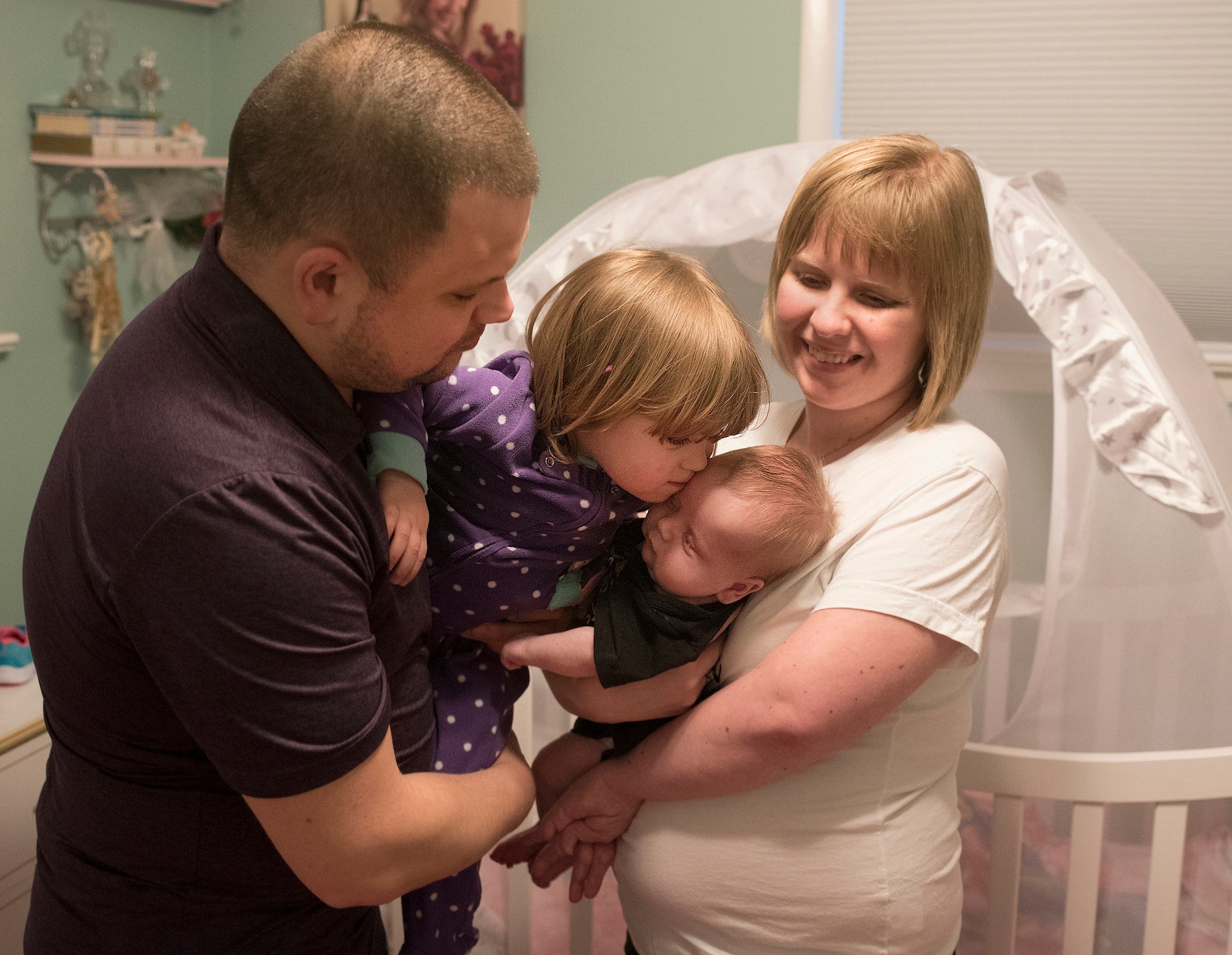
Amazing thing
Christina had no experience with babies. She usually avoided them. She was too afraid to hold them because of her paralysis.
But if she was going to be a mother, she wanted to be hands-on, as much as possible.
As soon as she confirmed she was pregnant and until she was too big to continue, Christina practiced the skills that go with baby care. It required outpatient occupational and physical therapy three mornings a week before heading to work at the Bucks County Intermediate Unit, where she is a speech pathologist.
Her pregnancy was treated as high risk because of her medical past, and in her third trimester, she developed a potentially dangerous condition that reduces bile flow, which can bring on premature labor, fetal distress and stillbirth.
During her 35-week checkup, the doctor felt her water sac bulging and the top of the baby’s head. Christina was sent to the emergency room. There, doctors told her that she was four centimeters dilated and her contractions, which she didn’t feel, were two minutes apart. She was admitted and given medication that stopped the contractions and released on bed rest after five days. The next week doctors induced labor, as planned, at 37 weeks.
Following 12 hours of labor and four pushes, Madelyn Rose Paravecchia arrived on June 5, 2017.
First-time parent nerves took over for the couple. Practicing parenthood with dolls was a lot easier than an unpredictable newborn.
Christina ended up staying in the hospital three additional days so she could work directly with occupational and physical therapists and Maddie. She continued therapy for three months after she went home.
Occupational therapist Krista Scheffler has worked with patients who experienced paralysis and a loss of motor skills after a traumatic brain injury or stroke, but most were older. Christina was her first client with a newborn.
“It was like, ‘Oh, this is going to be a tough one,'” Scheffler said. “Everything is made for two hands. It’s a very two-handed world when it comes to an infant.”
Having one usable arm wasn’t the only obstacle. Christina has weakness throughout her left side, which makes balance an issue, Scheffler said. She also walks with a leg brace, so her gait is slower and bending down isn’t a natural motion.
Scheffler had to do a lot of online research for techniques and modifications that Christina could use, as well as supportive and adaptive devices. One is a lanyard hooked into the car seat straps, which allows Christina to use her body weight to pull and tighten them. The high chair is at its lowest height setting, which makes it easier to get the baby in and out.
The way she changes a diaper is mind-boggling.
“That is the most amazing thing,” Scheffler said. “She has the patience of a saint.”
No matter what task was put in front of her, Christina kept at it until she mastered it, Scheffler said.
“Everything she does is amazing. And she is great with those kids.”
‘You just do it’
Christina and Vince learned about baby No. 2 on the first day of their first vacation without 14-month-old Maddie last year.
This time, the couple ended up taking a third pregnancy test, after the first two came back positive.
“We were both so shocked, we didn’t know what to say or do at that point,” Vince said.
They spent the rest of the vacation processing and brainstorming how they were going to handle two kids. They’d seen young families around town and in church with more than one kid and wondered, how do they do it?
“What we realized is, you just do it,” Christina said. “You wake up in the middle of the night, open one eye when you hear a cry. Who is crying, and what size diaper do we need?”
The second pregnancy was difficult, too. In the second trimester, the bile flow condition returned. Christina also developed a complication where the placenta covers the cervix, which can cause severe bleeding during pregnancy and delivery.
She was warned to avoid lifting heavy things, like a newly walking toddler. But she kept working until five days before Amelia Grace was born, on March 20. She arrived at 37 weeks, just like her sister.
Like he did after Maddie’s birth, Catarro’s husband, Albert, brought a birthday cake into the hospital room. The same priest who blessed Maddie an hour after she was born was at Christina’s bedside within an hour to bless Amelia.
The new family of four quickly learned that two kids are double the fun — and the work.
“It’s exhausting,” Vince said. “I’ve never been so continually tired in my life.”
Last year, Christina developed severe shoulder pain in her one working arm, making it agony to move.
Her doctor initially diagnosed a torn rotator cuff from repetitive heavy lifting, Catarro said. Another specialist determined the problem was inflammation because she was bearing all her weight on her right side. After two doses of steroids, Christina felt better and she was able to resume full care of Maddie.
Once Amelia arrived, though, the pain flared up again. And again, it forced a fiercely independent Christina to do something she hates: accept help.
Lynne Catarro, her husband or teens from church help Christina around the house during the week after work, until Vince gets home. Someone at Maddie’s daycare meets Christina in the parking lot to get the toddler in and out of her car seat. Lynne or Vince’s mom watches Amelia while Christina is working. Extended family and friends are invaluable resources, the couple said.
But most of the time, Christina and Vince rely on each other.
“There is no way I could do this without Vince,” Christina said. “He is a godsend to me. He is absolutely exhausted because he does more than his share.”
Vince, as usual, turns the conversation back to his wife.
“It’s hard because just given the situation there is a lot of stuff I have to do, and that is OK, but it’s physically demanding,” he said. “Two kids at once is very difficult, but I know Christina could do this if she absolutely had to, God forbid. I know I could do it if I absolutely had to, God forbid. But she is a godsend to me because of everything she is willing to do and able to do.”
A mother’s love
During Christina’s first pregnancy, her mother kept a journal so she could preserve every detail for her daughter.
“I didn’t want her to forget any moment of what she was going through,” Lynne Catarro said.
The emotions she experienced as she watched her granddaughters being born was so profound, no words can truly describe it.
“I didn’t know I had that much more love inside me,” she said. “It’s a love like I had never experienced before.”
It’s the same love she sees in Christina’s eyes when she looks at her daughters.
“She is a fabulous mom. Her confidence is like no other now.”
For Christina, of all the lessons motherhood has taught her, the greatest so far might be letting go of her need for perfection, something she has striven for with every role, every achievement since her surgery.
“Motherhood brings a whole new set of challenges. It’s a constant effort to stay mentally and emotionally in the game, but the girls and my family are beyond worth it,” Christina said.
“What I’ve come to realize is that different is OK. The way I care for the girls might look different or take a bit longer, but it always gets done, and it’s done with unconditional love.”
WHYY is your source for fact-based, in-depth journalism and information. As a nonprofit organization, we rely on financial support from readers like you. Please give today.


